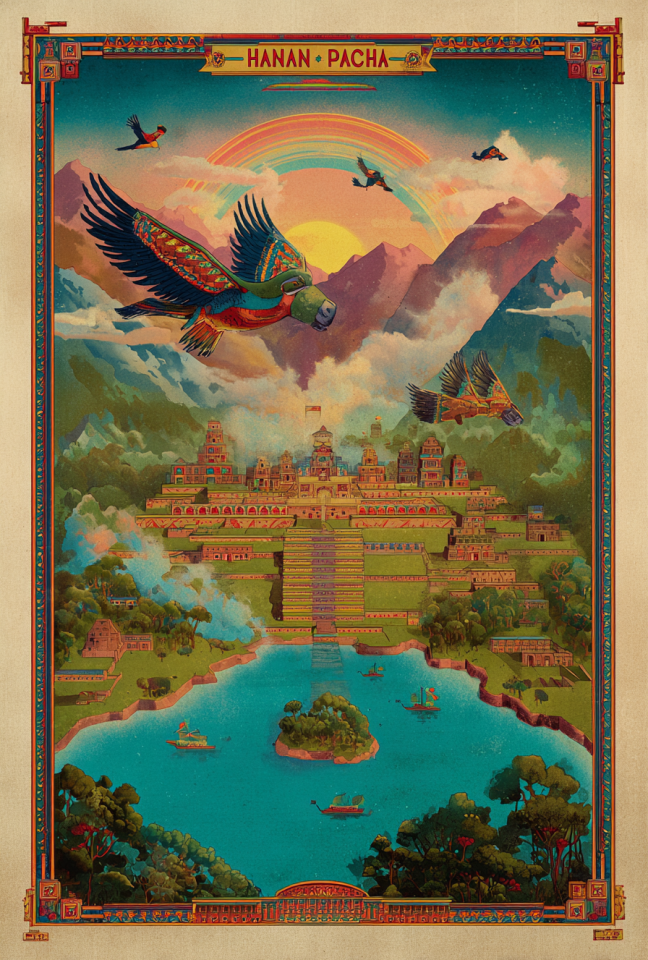Hanan Pacha is the upper world — the realm of celestial order, sacred ancestry, and solar truth. Suspended above the earth yet woven into its rhythms, it is the luminous domain of Inti, Mama Killa, and the Inca ancestors who achieved harmony with divine law. Far from an ethereal abstraction, Hanan Pacha is a radiant plane of intentionality, where every element exists in alignment with the sacred dualities of the cosmos. It is the mirror of terrestrial balance perfected — the place from which guidance flows downward and to which righteous souls ascend. Though once accessible through ritual and sacred altitude, the pathways to Hanan Pacha now lie sealed behind the Veil, closed when reverence gave way to rupture.
Landscape and Essence
Hanan Pacha unfolds in layers of luminous clarity. Its terrain mimics the highest mountains of the Mortal Realm — but purer, without erosion or decay. The sky is a living vault, painted in deep blue and brilliant gold, where constellations pulse with sentient rhythm. Rivers of light trace sacred geometries through valleys of silver mist, and each step echoes like a drumbeat in perfect time. The air carries the scent of maize and rain-soaked stone. Terraces of celestial agriculture stretch across hillsides not to grow food, but to preserve the memory of provision. Time does not move forward here; it moves *with* — circular, seasonal, and reverent, like a dance still unfolding.
Inhabitants
The Inca ancestors dwell here — not as ghosts, but as elevated forms of their truest selves. These are the *mallki*, the ancestral spirits made whole, bearing features of both sun and soil. They live in harmony with the deities who shaped the cosmos: Inti the Sun, Mama Killa the Moon, and Illapa the bringer of storms. Their forms are radiant, clothed in light, yet grounded in gesture and purpose. Hanan Pacha is also home to the *huacas* — sacred spirits that once inhabited mountains, springs, and stones in the Mortal Realm — now drawn upward to fulfill eternal roles. There is no idleness here. Every being has a function: to observe, to guide, to uphold balance with serene dignity.
Cultural Significance
To the Inca, Hanan Pacha was not simply where the gods lived — it was where justice, fertility, and social order originated. The Sapa Inca was believed to be descended from Inti and destined to return to Hanan Pacha upon death. Rituals, from solstice celebrations to offerings buried in mountaintop shrines, were designed to maintain harmony with this upper world. The construction of cities like Cusco reflected celestial geometry meant to align the Mortal Realm with its heavenly counterpart. When colonial disruption severed these practices, the conceptual bridge to Hanan Pacha fractured — not in the heavens, but in the collective heart. Still, the memory of its radiance lingers in the mountains and in the whispered prayers of those who remember.
Role in the Divine Realm
Hanan Pacha is the realm of cosmic authority and benevolent oversight. It does not dominate the Divine Realm through power, but through alignment — a steady and glowing axis of reciprocity. It exists not above other realms in hierarchy, but above them in tone, functioning as the divine overseer of agricultural cycles, family lineages, and moral equilibrium. Hanan Pacha is the heart of *ayni* — sacred reciprocity — where divine beings do not rule as kings, but serve as balanced stewards. The realm holds the cosmic contract between effort and grace, memory and becoming.
Interactions with Other Realms
Hanan Pacha was once closely aligned with the Mortal Realm through mountains, stars, and ritual altitude. Pilgrimage to high peaks, alignment with solstices, and precise offerings were ways to thin the Veil — and for a time, the highest shamans, known as *paqos*, could dream or climb their way into communion. But conquest broke the chain of rites, and the sacred architecture of connection was desecrated. With the loss of balance, the Veil around Hanan Pacha became opaque, gently but irrevocably. Only the sun gods may now reach down directly, and only ancestors of perfect resonance rise up to dwell there. Its terraces remain tended, but few remember the path.
















